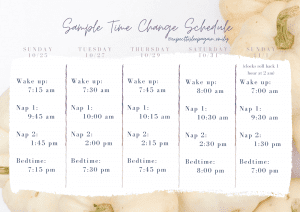It’s that time of year again. The daylight savings time is coming, and that means hours are getting longer, the weather is getting warmer, and it’s time to “spring ahead”. That precious hour of sleep will magically disappear.
Since the Daylight Savings Time begins at 2am on a Sunday, some folks are able to sleep in the hour, go to bed at their regular time Sunday night, and be right as rain come Monday. Some folks, like myself, might be working through the time change, so likely won’t be sleeping anyways.
The rest of you all will probably be thrown off a little bit, it may just be a day or two, or it could take a week or so to get back to feeling normal. It’s been proven that the time change is not healthy for people yet for some bizarre reason we keep on doing it.
So, how should you tackle Daylight Savings Time to reduce the side effects for springing forward?
Do nothing!
For adults and kids who are pretty flexible, this is the best option. Wake up at your regular time on Sunday and then do bedtime at the regular time. You (or your child) might feel a little tired for a day or two but this (for the flexible ones) will be brief.
Slowly Shift the Schedule
This is for the ones who are not very flexible and losing an hour of sleep or any changes to their schedule will throw them out of whack for ages. The key here is you want to shift the schedule backwards 15 minutes every couple of days. By the time the time changes, the schedule will be exactly how it was before (by the clock).
For example:
Based on a sample schedule of waking up at 7 am with 2 naps.

Embrace Later Wake-up and Bedtimes
This is a method that doesn’t usually stick but can be effective for some. If you have been hoping to get your kiddo to sleep until 7am instead of waking at 6 am, this is your chance to try to make the shift. When the time change comes, let them sleep until 7am. Then shift their schedule back one hour.
For example, their current schedule might be wake up at 6am, nap at 12pm, bedtime at 6pm. Once we make the leap forward, let them sleep until 7am, move nap to 1pm and bedtime to 7pm.
Do note that this definitely doesn’t work for everyone, and often for kids, it only works temporarily. But, it is worth a shot!
Other strategies to beat the leap?
Get outside!
Help reset your internal clock by getting out into the sunlight in the morning. Not only does this help wake you up but it has also been shown to help production of melatonin at night. This is a great time to also get some exercise in, which again helps wake you up and sleep better at night.
Stick to your routines (or create solid routines)
Keep (or start) some great routines, and no I don’t mean just pouring yourself a coffee so you have energy to keep up with the kids. Those morning routines of getting up, dressed, eat, maybe some yoga or light exercise. Signal your (and your child’s) body that it is time to be up and awake. This also goes for bedtime. Remember to wind down a bit before bedtime, avoid rough play, and screen time. Maybe do some soothing yoga or meditation, get into PJs and read a book, helping signal it’s time for bed.
Frankly, it’s ridiculous that this time change stuff is still a thing. But unfortunately, we have to find a way to cope with it in a way that best suits our families. And, every family is going to handle it a little different. Just know if you are struggling with it, you are not alone and there is help!










